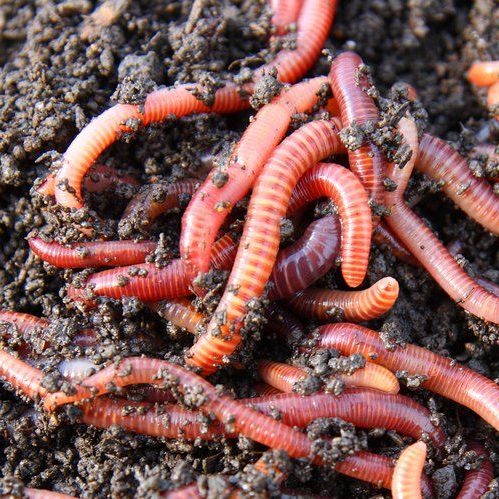Achieve a Vibrant Lawn Using Lake Hickory Bait Lawn Care Resources
Achieve a Vibrant Lawn Using Lake Hickory Bait Lawn Care Resources
Blog Article
Red Wigglers: The Unsung Heroes of Organic Waste Recycling
Red wigglers, or Eisenia fetida, function as vital agents in the natural waste reusing procedure, changing discarded materials into important vermicompost. Their effective break down of organic issue not only enhances soil top quality yet additionally adds to sustainable waste monitoring techniques. As the globe significantly looks for solutions to fight waste accumulation and improve farming performance, comprehending the role of these worms becomes important. What mechanisms permit them to thrive in garden compost settings, and exactly how can they be efficiently used in both household and business settings? Exploring these questions reveals the broader effects of vermicomposting in our eco-friendly landscape.
What Are Red Wigglers?
The remarkable durability of red wigglers, scientifically called Eisenia fetida, highlights their essential duty in organic waste recycling. These tiny, reddish-brown earthworms are normally located in breaking down raw material, such as garden compost heaps and manure stacks. Lake Hickory Bait. Unlike other earthworm types, red wigglers prosper in nutrient-rich atmospheres and are extremely efficient at breaking down organic products, making them necessary for vermicomposting

(Red Wiggler Express)Along with their duty in waste decrease, red wigglers contribute to soil health and wellness by improving dirt structure and aeration with their tunneling activities (Lake Hickory Bait). Their presence in composting systems not only improves disintegration prices however likewise advertises a lasting strategy to waste monitoring, showing their value in eco-friendly preservation initiatives
Benefits of Composting With Worms
Composting with worms, specifically red wigglers, offers numerous advantages that enhance both waste monitoring and dirt health and wellness. These worms successfully break down organic waste, converting it right into nutrient-rich vermicompost that improves dirt. This procedure accelerates decay, permitting a faster recycling of cooking area scraps and other organic materials compared to traditional composting methods.
Furthermore, the vermicompost produced by red wigglers is including useful bacteria, which aid improve dirt framework, aeration, and moisture retention. This improves the general health of plants, advertising vigorous development and increased returns in yards and farming settings. Moreover, the usage of worms in composting lessens the production of greenhouse gases, such as methane, adding to an extra lasting waste monitoring system.

How to Start Vermicomposting
Developing a vermicomposting system is an uncomplicated procedure that can produce significant advantages for both waste monitoring and dirt enrichment. To start, pick a suitable container, such as a plastic bin or wooden box, with ample air flow holes to ensure appropriate airflow. The dimensions must preferably be about 2 feet by 3 feet, permitting enough area for the worms to grow.
Following, prepare bed linens product, which can contain shredded newspaper, cardboard, or coconut coir. This bed linens needs to be dampened to develop an ideal environment for the worms. When the bedding remains in area, present red wigglers (Eisenia fetida) right into the bin, normally around one pound of worms for every square foot of surface area.
Following the placement of worms, add organic waste, such as fruit and veggie scraps, coffee premises, and smashed eggshells. Prevent including dairy, meat, or oils, as these can create odors and attract pests. Finally, position the bin in a shaded, temperature-controlled location to keep ideal conditions for worm task. With these actions, you will properly start a vermicomposting system that adds to lasting waste management and enriches your dirt.
Maintaining a Healthy And Balanced Worm Bin
(Red Wiggler Express)Maintaining a worm bin flourishing calls for routine attention and treatment to guarantee the wellness of the red wigglers and the effectiveness of the composting process. Proper upkeep begins with monitoring the see this wetness degrees; the container ought to perspire but not saturated. A good guideline is to maintain an uniformity comparable to a wrung-out sponge.
Aeration is critical also. Gently mixing the bed linens and food scraps every few weeks avoids compaction and makes certain that all worms have accessibility to oxygen. Additionally, it is very important to feed the worms suitably. A balanced diet regimen of vegetables and fruit scraps, coffee premises, and smashed eggshells ought to be used in small amounts to stay clear of overfeeding, which can result in smells and parasites.
If the bin comes to be also warm or chilly, the worms might end up being stressed. By carefully taking care of these variables, one can keep a durable and efficient worm bin.
Effect On Sustainable Living
The effective upkeep of a worm bin not only profits the health of red wigglers but additionally adds substantially to sustainable living techniques. By reusing natural waste, such as kitchen scraps and yard particles, red wigglers assist draw away significant quantities of material from land fills. This decrease in waste not only lowers greenhouse gas exhausts however also decreases the environmental burden connected with waste administration.
Furthermore, the spreadings created by red wigglers serve as a nutrient-rich natural fertilizer, enhancing dirt health and advertising plant growth. This natural alternative to chemical plant foods supports lasting farming and gardening methods, decreasing dependence on synthetic inputs that can damage ecological communities. Additionally, worm composting cultivates understanding of waste monitoring, motivating people and neighborhoods to take on more lasting practices.

Conclusion
In summary, red wigglers function as important factors to natural waste reusing via their reliable disintegration of natural products. Their ability to produce nutrient-rich vermicompost enhances soil health and supports sustainable agricultural techniques. By incorporating vermicomposting right into waste management techniques, people and areas can significantly reduce waste while advertising environmental sustainability. The function of Eisenia fetida in promoting healthy and balanced environments highlights the value of these organisms in accomplishing sustainable living and enhancing dirt fertility.
Report this page